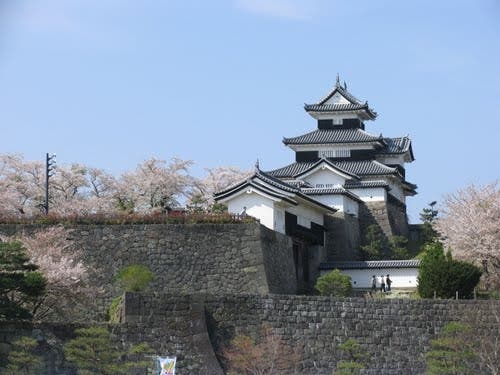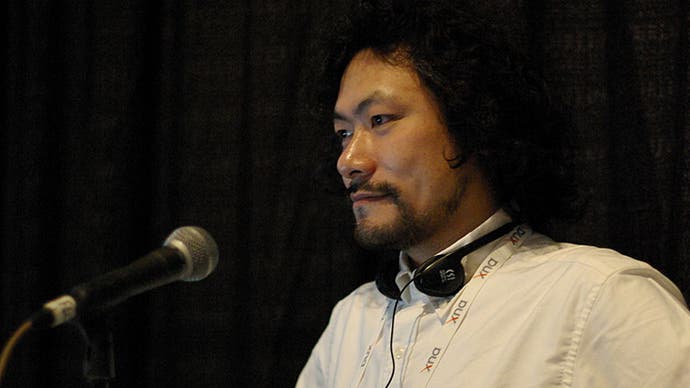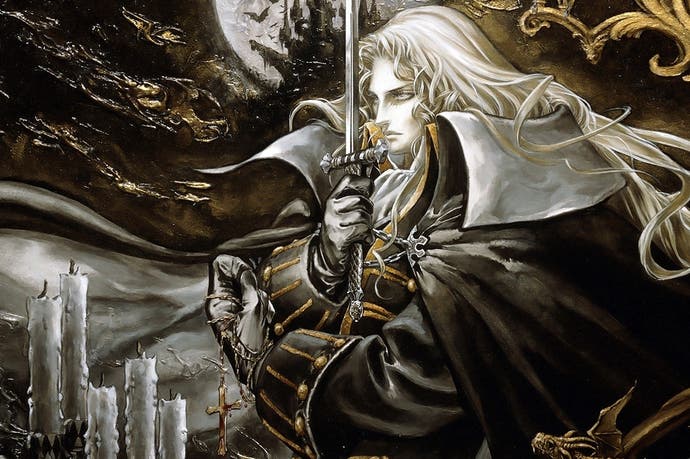Unfinished symphony: Castlevania's keeper speaks
Koji Igarashi tells his story for the first time.
For more than 500 years, the swipe of Komine Castle's rooftops provided the dominant silhouette on the city of Shirakawa's skyline, a chunky arrow pointed towards the heavens. The castle was ruined in 1868, burned to the ground during the Battle of Aizu. The city mourned its loss for generations.
But not Koji Igarashi, who was born exactly one hundred years after the bloody siege. He would gaze at the ruins from his bedroom window. For this young boy, the castle's appeal wasn't in the historical secrets buried beneath the undergrowth, but in the promise of contemporary adventures to be found amongst its rubble.
When he was a teenager, Igarashi was given a cheap camcorder by his parents. It was the impetus he needed. He broke into the ruined castle's grounds and filmed what he saw. He would return there most mornings, each time questing a little farther into its derelict mystery. It wouldn't be the last time that Igarashi returned to an abandoned castle to unearth a new adventure.
In 1997 he designed Castlevania: Symphony of the Night, a game which opens as its lead protagonist sprints towards a castle, a vast building comprised of a complicated nest of riddle-filled rooms and corridors. Symphony of the Night not only entered the video game canon as one of the greatest 2D adventure games yet made, but it also formalised the rare emergence of a new style of game, one to which it nobly lends its name: the Metroidvania. For Igarashi, there's gold in these wild, unknown, historical places. Perhaps for this reason, after close to three decades creating video games at Konami, he has decided to leave the safety of a Japanese job-for-life to make his way as an independent game-maker.

Before this next adventure, he wants to tell his story for the first time. We meet in the lower guts of San Francisco's Marriot Marquis hotel, a three-towered building with as many rooms and offshoots as a residence found in one of his games. Now in his mid-forties (he turned 46 two days before he publicly announced his departure from Konami at the Game Developer's Conference, during which we meet), Igarashi's height and rangy legs are accentuated by his skin-tight black jeans. He wears all black most of the time ("occasionally I wear dark blue," he quips), a murky aesthetic reflected in the gothic architecture and ambiance of many of his games.
There is no hint of darkness in his manner, however. Perhaps emboldened by the freedom of departing a Japanese corporation, he offers extended answers to my questions, often breaking into a deep and pleasing laugh. When he reveals that he used to be a fan of break-dancing as a teenager, he demonstrates a simple move he still remembers. A maid noisily vacuums the room around us. Unperturbed, Igarashi smiles serenely. He is a person who knows himself, who is at peace with his purpose and who has time if not to spare, then at the very least to enjoy.
His path into the video game industry, however, was less sure-footed, defined by interminable sidetracks and unfortunate obstacles. Igarashi's father was a lumberjack, which influenced the young boy's ambitions. "I wanted to become a carpenter, even when I was at primary school," he says. But that dream shifted as Igarashi grew older. "There weren't may video games around in the late 1970s so I spent most of my time drawing," he says. He joined a school art club and, for a while, dreamed of becoming an artist, until he realised that he lacked the talent of the other children in the group. When he was 10 years old Igarashi visited a relative, who had recently bought a Pong machine, Atari's proto-tennis game. Igarashi's interest in video games was piqued, but it wasn't until he saw a port of the 1980 arcade game Crazy Climber running on a older friend's PC two years later that he decided to learn how to make one himself.
Igarashi's family could not afford a personal computer, but he had access to two machines: one that was owned by a friend, and a display model that was set up in a local electronics store. Igarashi taught himself how to program Basic by reading enthusiast magazines. He would alternate between his friend's house and the electronics store, writing simple games and then leaving them for his friend or visitors to the store to play. His first game was a Gundam-themed shoot-'em-up, a genre to which he would later return while working on Gradius 2 at Konami. "I was happy as I got to create," he says. As he improved, Igarashi, who excelled at mathematics at school, soon became frustrated with the limitations of Basic. He borrowed a book on how to write more powerful and flexible Assembly Language from a friend, which he never returned.
As Igarashi neared the end of his university degree, he was almost knocked off course again. One of his senpai mentors offered to show him around his business, the now-defunct CG company Grafika. "I went because I wanted to see what it was like," he says. "They asked me a few questions - it was light and fun - but when I returned to college I found out they'd made me a formal job offer off the back of what they considered to be an interview." At the time, if a Japanese student was offered a position at a company they were bound by tradition to turn down any subsequent offers from other companies. "I was in a real bind as I had a job offer from a company that I didn't want to work for," he says. Igarashi fought with the HR department and they reluctantly agreed to rescind the offer. When they finally relented, Igarashi accepted the next subsequent offer that came his way: a role as a programmer at the video game company Konami.
"We were allowed free rein to do pretty much whatever we wanted. This allowed us to change the Castlevania design in significant ways."

Even inside a video game studio, Igarashi's plans to become a game-maker were thwarted. He was hired at the precise moment that Konami established a new wing to the business to create educational software. Igarashi and a number of other graduate employees who were eager to start making games were instructed to build a business training simulation, in which the player would learn how to run a successful business. "When our team received the brief, Konami's management used the word 'simulation'," he says, eyes twinkling. "We all loved Fire Emblem at the time and, of course, we wanted to make games, not software, so we interpreted the instruction as a brief to make a business-themed Fire Emblem game."
Despite the team's efforts to get the masquerading game built, the project was cancelled after 12 months of development, towards the end of 1990. Igarashi was moved to a new team and tasked to develop programming tools for the PC Engine game console, where he worked on Twin Bee and Gradius 2. Igarashi's career then took another unexpected turn as he was moved onto the development team for a new kind of game, the dating simulation game Tokimeki Memorial. Even though he was employed as a programmer, Igarashi was instructed to write the storyline for Tokimeki Memorial, in which players date a slew of high-school girls.
At that time Igarashi's girlfriend (who he would later marry) worked in the adjacent office on one of Konami's flagship titles, Castlevania: Rondo of Blood. She would offer him tips on storyline features and plot points, and even took him to local clothes boutiques to research potential locales for date spots in the game. In return, when the soupy romance plots of his game became overbearing, Igarashi would creep into her office to play Rondo of Blood as an escape.
Despite Igarashi's misgivings, Tokimeki Memorial was a hit, something approaching "a social phenomenon at the time," he says. The game's success meant that his boss was keen for him to write a sequel, but Igrashi protested. "I told my boss that I couldn't," he says. "I'd exhausted all of my tales of romance. I had nothing more to give." His superiors relented and, to Igarashi's astonishment, produced a list of all the game projects currently in development at the company. "He told me that due to Tokimeki Memorial's success I was allowed to pick the game I wanted to work on next." Igarashi spotted Castlevania and jabbed his finger onto the page. "I immediately said: 'That one.'"
In the mid-90s Konami has three offices across Japan - the headquarters in Kobe and two supporting studios, one in Sapporo and one in Tokyo, where Igarashi was based. As the Castlevania series was one of the company's most treasured, it was developed at its Kobe headquarters. Castlevania: Symphony of the Night was to be developed in Tokyo and was, as such, deemed a spin-off.
"Because of that we were allowed free rein to do pretty much whatever we wanted," he says. "This allowed us to change the Castlevania design in significant ways. It didn't make sense to us that this was a game about vampires and the main character was this buff warrior. So we used the opportunity to make the lead character sleeker and more similar to the vampires." Likewise, the team reduced the length of the whip ("it was always far too long") and decided to make a much more substantial game, partly in an effort to reduce the number of re-sales of the game from players who finished it quickly. "We were allowed to do all of these things simply because it wasn't viewed as a core Castlevania title," he recalls.
He team had no inkling that Symphony of the Night was a special game, or that it would establish new conventions in the medium which would go on to define all subsequent 2D Castlevania games. "We were so busy we had no free mental time to really reflect on what we were creating," he says. The workload was gruelling. Igarashi and the rest of his team worked over the New Year in 1996, a time when the country traditionally ceases work. "On midnight the New Year's bell is rung at temples," Igarashi says. "I remember being at my desk when the bell tolled. We worked hard then, but our sense was that this was just a mere offshoot to the main series. Nobody thought it would end up having the impact that it did."
The pressure to expand the game to hold players' interest for longer was significant. It was from this goal that one of the game's most famous and generous features originated. Igarashi recalls: "One of the other team members said: 'Wait a minute. If we flip the castle upside down during the game then we'd have twice as much content." The team tried the unconventional idea and found that it worked. "We didn't have to create much additional artwork at all - it merely meant adding some new enemies. It almost doubled the size of the game."
"Seeing Inafune's example showed me that fans have power. If you're able to give your fans what they want then there are opportunities for indie developers."

As with many high acclaimed and successful games created by a person in their twenties, Symphony of the Night has cast a tall shadow over Igarashi's subsequent career. Just as Markus Persson has struggled to create a game post-Minecraft, even Igarashi's strongest subsequent projects (14 of which bare the Castlevania name) have failed to inspire the same devotion. A few years ago, one Konami employee told me that he refuses to be interviewed about the game for which he is best known. But today Igarashi shows no bitterness toward Symphony of the Night. "No, I am honoured to have a pinnacle game like that, something which people remember with such happiness," he says. "But perhaps it's human nature that whenever you discover something new then that is the moment people tend to recall."
Symphony of the Night's moment has endured. The term Metroidvania - a contraction of the words Metroid and Castlevania, the two games that established the genre's design traits - has fully entered the medium's lexicon (although Igarashi admits to me that he only heard the word for the first time last year when he saw a Facebook group dedicated to his game).
There are glimpses of Metroidvania design visible in a raft of contemporary titles, from indie examples such as Guacamelee and Teslagrad to blockbuster releases such as Batman: Arkham Asylum. But unlike this latter example, Igarashi has been unsuccessful in his attempts to move the design into 3D space. "I guess there are a lot of reasons for that," he says. "There's an enormous pressure when you move a game from 2D to 3D to increase the graphical fidelity - the stylisation that works in 2D often doesn't translate well. Another issue comes from camera angles. You have to think like a film director: how will you shoot the scene and so on. Unless that cinematic aspect is fully realised then the game can look unappealing. There are lots more things that can hold a design back."
It's these struggles that have partly led to Igarashi's decision to leave the company. A close friend advised him to consider striking out on his own last autumn, but it wasn't until January that he made the final decision, inspired by Keija Inafune's example. Inafune left Capcom to go independent in 2010, one of the first high-profile Japanese game designers to do so. He subsequently launched a successful Kickstarter to create a game inspired by his MegaMan series. "Seeing Inafune's example showed me that fans have power," says Igarashi. "If you're able to give your fans what they want then there are opportunities for indie developers."
For the first time in our conversation Igarashi allows the worry behind the cool exterior to flash. "I'm extremely nervous," he says. "I have a family and, to be honest, lifetime employment is attractive. To make this decision now gives me much anxiety." Igarashi's fears are understandable; the indie success stories that are so eagerly retold in the west through documentaries such as Indie Game: The Movie are almost non-existent in Japan, where few people have heard of the crowd-funding website Kickstarter.
Yet Igarashi knows that there is gold to be found in apparent ruin. "On the other hand: lots of fans have told me they want me to make games like Symphony of the Night," he continues. "I wasn't able to do that at Konami. Now I am able to do that and potentially make people happy. With that in mind, I am filled with tremendous excitement." The circle is almost complete then. Literally or symbolically, Igarashi will return to the castle.









